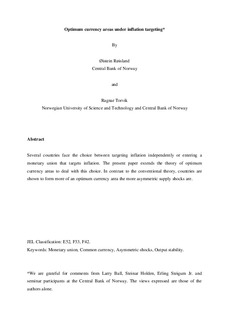| dc.contributor.author | Røisland, Øistein | |
| dc.contributor.author | Torvik, Ragnar | |
| dc.date.accessioned | 2018-06-06T08:51:04Z | |
| dc.date.available | 2018-06-06T08:51:04Z | |
| dc.date.issued | 1999 | |
| dc.identifier.uri | http://hdl.handle.net/11250/2500529 | |
| dc.description.abstract | Several countries face the choice between targeting inflation independently or entering a monetary union that targets inflation. The present paper extends the theory of optimum currency areas to deal with this choice. In contrast to the conventional theory, countries are shown to form more of an optimum currency area the more asymmetric supply shocks are. | nb_NO |
| dc.language.iso | eng | nb_NO |
| dc.publisher | Norges Bank | nb_NO |
| dc.relation.ispartofseries | Working Papers;10/1999 | |
| dc.rights | Attribution-NonCommercial-NoDerivatives 4.0 Internasjonal | * |
| dc.rights.uri | http://creativecommons.org/licenses/by-nc-nd/4.0/deed.no | * |
| dc.subject | JEL: E52 | nb_NO |
| dc.subject | JEL: F33 | nb_NO |
| dc.subject | JEL: F42 | nb_NO |
| dc.subject | monetary union | nb_NO |
| dc.subject | common currency | nb_NO |
| dc.subject | asymmetric shocks | nb_NO |
| dc.subject | output stability | nb_NO |
| dc.title | Optimum Currency Areas Under Inflation Targeting | nb_NO |
| dc.type | Working paper | nb_NO |
| dc.description.version | publishedVersion | nb_NO |
| dc.subject.nsi | VDP::Samfunnsvitenskap: 200::Økonomi: 210::Samfunnsøkonomi: 212 | nb_NO |
| dc.source.pagenumber | 21 | nb_NO |

